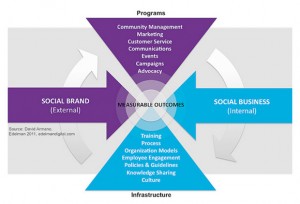Three Tips to Better Understand Social Business
It is very easy to confuse social media and social business. The graphic in this post, created by my colleague David Armano, is a great illustration of the differences between a social brand (for the purposes of this post, this is synonymous with social media) and social business. At a very high level, a social brand is what we all do from a communications perspective to include marketing, public relations, customer support and so on.

So what is a social business strategy? It helps evolve the thinking and preparedness of an organization by bridging internal and external social initiatives, which results in a more collaborative company and shared value for all stakeholders (customers, partners, employees). If you study the above graphic, a social business is very much focused on the internal dynamics of a company, from training and governance to knowledge sharing and culture. Social media policies and employee engagement also play a pivotal role in shaping a social business.
A social business strategy can almost be considered an enabler, because if you have your internal process and structures sorted out, it is much easier to scale your social media initiatives externally. Whether it is launching a global Facebook page or empowering employees to engage in social media, having a solid social business plan will help minimize mistakes.
As a marketing guy by trade, I will try to communicate the value of how a better social business strategy enables a better social brand.
- A social business enables better content
Content is the number one challenge for brands today. First, there is not enough of it and marketing teams continue to run out of creative and innovative ideas. Establishing a social business strategy will help identify other content sources, such as employees, partners and customers who love the brand as well as establish workflows for content ideation, creation, approvals and distribution. Additionally, a social business strategy will streamline content and ensure that it tells a consistent brand story across converged media – paid, earned and owned media channels. - A social business enables better customer relationships
Social customer relationship management (CRM) is a sub-strategy of social business. It will allow your brand managers and customer service staff to interact with customers in real-time using monitoring and engagement tactics. Platforms like Sprinklr, SpredFast and Shoutlet have built-in customer service and marketing workflows, as well as analytics that allow for the escalation of social conversations and measurement. In order for initiatives like this to actually work, internal team members from marketing, IT and support must collaborate (see the above graphic for reference).Promptly responding to customers when they have a problem drives better engagement, an increase in customer loyalty and enables brand advocacy. - A social business enables better analytics
Two things are happening in companies today. Either no one is measuring social media initiatives, or everyone is measuring social media differently. In either case, this is a huge problem; especially when the chief marketing officer of a company with many brands asks for a report that highlights all engagement, community growth and share of voice for an entire company, including its brands.
A social business strategy will ensure that there is one measurement framework and that it is rolled out properly, encompassing all of the stakeholder’s feedback and business requirements.
For some early thinking about social business, feel free to check out my book, Smart Business, Social Business. It takes a look at social business and how it can be deployed in your company.
Michael Brito is a senior vice president of social business strategy at Edelman Digital and was a session presenter at the PRSSA 2012 National Conference. You can catch him on Twitter or read up on his social business blog.
